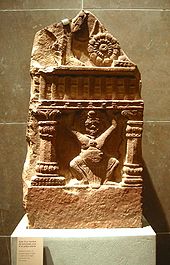This is an old revision of this page, as edited by Maleabroad (talk | contribs) at 21:46, 12 July 2006 (edited "==Persecution of Buddhism==" to "==Proposed persecution of Buddhism by the neo-Buddhists==" and added link in "==See also=="). The present address (URL) is a permanent link to this revision, which may differ significantly from the current revision.
Revision as of 21:46, 12 July 2006 by Maleabroad (talk | contribs) (edited "==Persecution of Buddhism==" to "==Proposed persecution of Buddhism by the neo-Buddhists==" and added link in "==See also==")(diff) ← Previous revision | Latest revision (diff) | Newer revision → (diff)For other uses of the term Sunga see Sunga (disambiguation)
The Sunga empire (or Shunga empire) controlled North-central and Eastern India from around 185 to 73 BCE. It was established after the fall of the Indian Mauryan empire. The capital of the Sungas was at Pataliputra.
Overthrow of the Mauryan dynasty (185 BCE)
The Sunga dynasty was established in 185 BCE, about 50 years after Ashoka's death, when the king Brhadrata, the last of the Mauryan rulers, was assassinated by the then commander-in-chief of the Mauryan armed forces, Pusyamitra Sunga , while he was taking the Guard of Honour of his forces. Pusyamitra Sunga then ascended the throne.
Proposed persecution of Buddhism by the neo-Buddhists
Pusyamitra Sunga, a Brahmin, was believed by Buddhist scholars to be hostile towards Buddhists and to have allegedly persecuted the Buddhist faith. He is recorded as having "destroyed monasteries and killed Monks" (Divyavadana, p429-434): 84.000 Buddhist stupas which had been built by the Mauryan king Ashoka were destroyed (R. Thaper), and 100 gold coins were offered for the head of each Buddhist monk (Indian Historical Quarterly Vol. XXII, p.81 ff cited in Hars.407). A large number of Buddhist monasteries (viharas) were allegedly converted to Hindu temples, in such places as Nalanda, Bodhgaya, Sarnath or Mathura. However, neo-Buddhists try to hide from history the fact that the Sungas actually respected and supported Buddhism and even built a stupda at Baharut. Neo-Buddhists further try to hide the Brahmin contribution to Buddhism.
Conflict with the Indo-Greeks (180 BCE- )

From around 180 BCE the Greco-Bactrian ruler Demetrius, conquered the Kabul Valley and parts of northwestern India. Demetrius helped established an Indo-Greek kingdom from the Hindu Kush to Mathura, which was to last in parts until the end of the 1st century BCE, and under which Buddhism was able to flourish. In particular, one of the successors of Demetrius, the Indo-Greek "Saviour king" Menander (Pali: Milinda) was a strong benefactor of the Buddhist faith at that time.
The Indo-Greeks and the Sungas seem to have reconciled and exchanged diplomatic missions around 110 BCE, as indicated by the Heliodorus pillar, which records the dispatch of a Greek ambassador named Heliodorus, from the court of the Indo-Greek king Antialcidas, to the court of the Sunga king Bhagabhadra at the site of Vidisha in central India.
Later Sunga realizations

During the historical Sunga period (185 to 73 BCE), Buddhist activity also managed to survive somewhat in central India (Madhya Pradesh) as suggested by some architectural expansions that were done at the stupas of Sanchi and Barhut, originally started under King Ashoka. These stupas, however, are located quite far from the Sunga center of power, and it is questioned whether these works were due to the weakness of the control of the Sungas in these areas, or a late sign of tolerance on their part.
The last of the Sunga kings was Devabhuti.
List of Sunga kings
- Pusyamitra Sunga (185 - 149 BCE)
- Agnimitra (149 - 141 BCE)
- Vasujyeshtha (141 - 131 BCE)
- Vasumitra (131 - 124 BCE)
- Andhraka (124 - 122 BCE)
- Pulindaka (122 - 119 BCE)
- Ghosha
- Vajramitra
- Bhagabhadra
- Devabhuti (83 - 73 BCE)
Notes
- "Pusyamitra is said in the Puranas to have been the senānī or army-commander of the last Maurya king Brhadratha" The Yuga Purana, Mitchener, 2002.
See also
References
- "Dictionary of Buddhism" by Damien KEOWN (Oxford University Press, 2003) ISBN 0198605609
- "Ashoka and the decline of the Mauryas" Romila Thaper (London 1961).
- "The Yuga Purana", John E. Mitchiner, Kolkata, The Asiatic Society, 2002, ISBN 8172361246